
A beehive is an enclosed structure in which some honey bee species of the subgenus Apis live and raise their young. Though the word beehive is used to describe the nest of any bee colony, scientific and professional literature distinguishes nest from hive. Nest is used to discuss colonies that house themselves in natural or artificial cavities or are hanging and exposed. The term hive is used to describe an artificial/man-made structure to house a honey bee nest. Several species of Apis live in colonies. But for honey production, the western honey bee and the eastern honey bee are the main species kept in hives.

A beekeeper is a person who keeps honey bees, a profession known as beekeeping.

Beekeeping is the maintenance of bee colonies, commonly in man-made beehives. Honey bees in the genus Apis are the most commonly kept species but other honey producing bees such as Melipona stingless bees are also kept. Beekeepers keep bees to collect honey and other products of the hive: beeswax, propolis, bee pollen, and royal jelly. Other sources of beekeeping income include pollination of crops, raising queens, and production of package bees for sale. Bee hives are kept in an apiary or "bee yard".
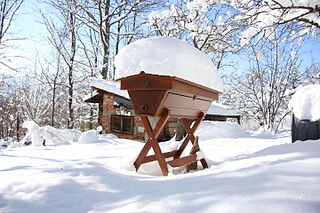
A top-bar hive is a single-story frameless beehive in which the comb hangs from removable bars. The bars form a continuous roof over the comb, whereas the frames in most current hives allow space for bees to move up or down between boxes. Hives that have frames or that use honey chambers in summer but which use management principles similar to those of regular top-bar hives are sometimes also referred to as top-bar hives. Top-bar hives are rectangular in shape and are typically more than twice as wide as multi-story framed hives commonly found in English-speaking countries. Top-bar hives usually include one box only, and allow for beekeeping methods that interfere very little with the colony. While conventional advice often recommends inspecting each colony each week during the warmer months, heavy work when full supers have to be lifted, some beekeepers fully inspect top-bar hives only once a year, and only one comb needs to be lifted at a time.
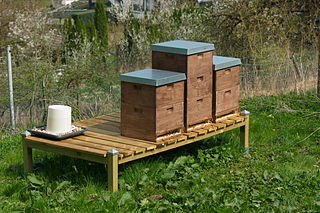
In modern American beekeeping, a Langstroth hive is any vertically modular beehive that has the key features of vertically hung frames, a bottom board with entrance for the bees, boxes containing frames for brood and honey and an inner cover and top cap to provide weather protection. In a Langstroth hive, the bees build honeycomb into frames, which can be moved with ease. The frames are designed to prevent bees from attaching honeycombs where they would either connect adjacent frames, or connect frames to the walls of the hive. The movable frames allow the beekeeper to manage the bees in a way which was formerly impossible.

A hive frame or honey frame is a structural element in a beehive that holds the honeycomb or brood comb within the hive enclosure or box. The hive frame is a key part of the modern movable-comb hive. It can be removed in order to inspect the bees for disease or to extract the excess honey.

Lorenzo Lorraine Langstroth was an American apiarist, clergyman, and teacher, and considered to be the father of American beekeeping. He recognized the concept of bee-space, a minimum distance that bees avoid sealing up. Although not his own discovery, the use of this principle allowed for the use of frames that the bees leave separate and this allowed the use of rectangular frames within the design of what is now called the Langstroth hive.

Charles Dadant was a French-American beekeeper. Along with Petro Prokopovych, Dadant is considered one of the founding fathers of modern beekeeping.

Moses Quinby was an American beekeeper from the State of New York. He is remembered as the father of practical beekeeping and the father of commercial beekeeping in America. He is best known as the inventor of the bee smoker with bellows. He was the author of numerous articles and several books on beekeeping.
The Stewarton hive is a type of historical bee hive. Extra boxes below allowed expansion of the brood, and thus strongly inhibited swarming and any tendency for the queen to enter the honey boxes, while expansion with extra honey boxes above the brood area gave ample space for the bees to create surplus honey stores that were easily harvested by the beekeeper. The introduction of this hive is credited to Robert Kerr, of Stewarton, Ayrshire, in 1819.
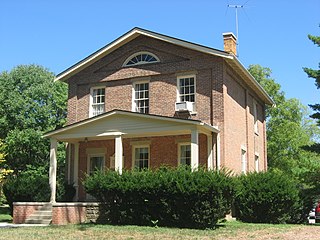
Langstroth Cottage is a historic building on the Western College campus of Miami University in Oxford, Ohio. It was designated a National Historic Landmark on June 22, 1976. The cottage, built in 1856, is now the home for the Oxford office of the Butler County Regional Transit Authority. It was purchased for Beekeeper L. L. Langstroth in 1859, and he lived there for the next 28 years, conducting research and breeding honey bees.
Charles Butler, sometimes called the Father of English Beekeeping, was a logician, grammarian, author, priest, and an influential beekeeper. He was also an early proponent of English spelling reform. He observed that bees produce wax combs from scales of wax produced in their own bodies; and he was among the first to assert that drones are male and the queen female, though he believed worker bees lay eggs.

Honey extraction is the central process in beekeeping of removing honey from honeycomb so that it is isolated in a pure liquid form.

Beekeeping in New Zealand is reported to have commenced in 1839 with the importing of two skep hives by Mary Bumby, a missionary. It has since become an established industry as well a hobby activity.

Heath beekeeping was a specialist form of beekeeping, which was intensively practised by beekeepers on the Lüneburg Heath from the Middle Ages until the 19th century, but which is now very rarely encountered. It was also referred to as Lüneburger SchwarmbienenzuchtLüneburger Heideimkerei or Lüneburger Korbimkerei. Typical features were beehives made of plaited straw baskets or skeps, the use of heathland flowers, frequent moving of bees to worthwhile feeding areas and the enormous multiplication of bee colonies through swarming.
Beekeeping in the United Kingdom is the maintenance of bee colonies by humans within the United Kingdom. It is a significant commercial activity that provides those involved with honey, beeswax, royal jelly, queen bees, propolis, flower pollen and bee pollen. Honeybees also provide pollination services to orchards and a variety of seed crops.
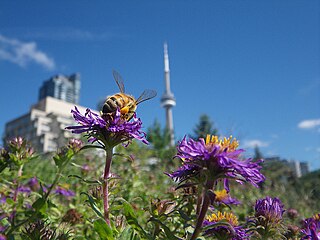
Urban beekeeping is the practice of keeping bee colonies (hives) in towns and cities. It is also referred to as hobby beekeeping or backyard beekeeping. Bees from city apiaries are said to be "healthier and more productive than their country cousins". As pollinators, bees also provide environmental and economic benefits to cities. They are essential in the growth of crops and flowers.
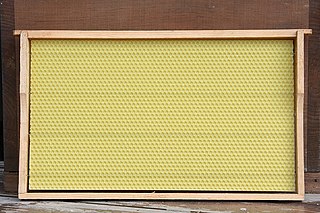
Wax foundation or honeycomb base is a plate made of wax forming the base of one honeycomb. It is used in beekeeping to give the bees a foundation on which they can build the honeycomb. Wax foundation is considered one of the most important inventions in modern beekeeping.

Beekeeping in Australia is a commercial industry with around 25,000 registered beekeepers owning over 670,000 hives in 2018. Most are found in the eastern states of Queensland, New South Wales, Victoria and Tasmania as well as the south-west of Western Australia.

Franz Hruschka, Franz von Hruschka, Francesco De Hruschka, František Hruška was an Austrian/Italian of Czech origin officer and beekeeper known as the inventor of the honey extractor, an invention he presented in 1865 at the Brno Beekeeper Conference.




















